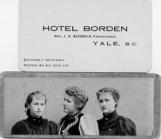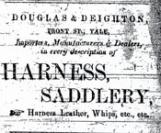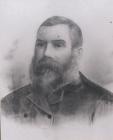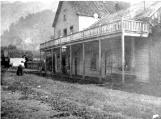15
Benjamin Douglas & Richard Deighton1839-1900 ; 1821-1886
Douglas & Deighton Saddlery& Harness, and Post Office
Two men from very different backgrounds met in Yale and formed a business and friendship, the presence of which still lingers throughout the history of Yale.
Benjamin Douglas and Richard Deighton operated a saddle shop and post office on Front Street. The store was in existence prior to the certainty that Yale would soon reemerge as an essential link in B.C.'s transportation route with the coming of the Canadian Pacific Railway (CPR).
Their presence within Yale during the quiet part of the 1870's was well remembered when Yale became prominent once again: In a July 1880 issue of the Inland Sentinel it reads that "the fine premises recently erected by Messrs. Douglas & Deighton, and now occupied by that enterprising firm. These gentlemen, like other pioneers, stood by Yale 'when times were dark and friends were few,' and now enjoy the tidal-wave of prosperity." 1
Benjamin Douglas was born near Huntingdon, Quebec, in 1839. 2 Attending the local public schools he left home at the age of 12 to make his own way from Kingston to New York and then San Francisco. In 1862, the same year he arrived in San Francisco, he followed the rumours of gold to the Cariboo, where he made his living primarily through mining.
Richard Deighton was born in 1821 3 in Scotland, although he was of English origin. He arrived in Victoria around 1860 and followed the lure of gold to Yale and up into the Cariboo region where he also engaged in mining. While mining at Harvey Creek Deighton achieved the position of Justice of the Peace and in 1874 he was appointed as magistrate as well.
Perhaps these two formed their friendship while mining in the Cariboo, or through Deighton's position as a magistrate. Either way the year 1876 saw them engaged in a new business enterprise in Yale, which was Douglas & Deighton Saddlery and Harness. A description of the business as it existed was "Their harness and saddle trade extends to the far interior, and secures orders wherever once introduced." The article goes on to describe the fine job that Douglas continues to do as postmaster and then resumes describing the business. "At present one side of the new building is conveniently fitted up for the post-office, the remainder of the first floor devoted to their store for harness, saddles, whips, etc., while the upper floor is occupied by their workmen as workshops. Thus the whole building is utilized to advantage." 4
The two business partners made a number of investments in real estate, both individually and co-operatively. Aside from their saddlery shop the partners held a lot of outside responsibilities, some of which they shared. They both served as justices of the peace and held active positions in the Cascade Lodge No. 10 A.F. & A. M. Richard was also Treasurer and Trustee of the Yale Fire Department in 1882 and 1883.
In 1884 Douglas moved to New Westminster, leaving Deighton to run the shop, although he was still listed as co-owner of the business. Richard remained in Yale until 1885, about which time the business also moved. What brought about his decision to leave Yale is not known, perhaps he felt that Yale as town of central importance would soon be over, or he may have been feeling poorly and so moved to New Westminster in order to be closer to his friend. What we do know is that Richard Deighton died in 1886 in New Westminster, B.C. at the age of 64. 5
Benjamin Douglas sustained the business in New Westminster and continued to invest in property while promoting the idea of an electric railway in New Westminster. Douglas became president of both the New Westminster Electric Railway & Light Company and the Westminster & Southern Railway Company. Douglas while not active in politics was elected a member of the city council less than a year after he made New Westminster his home.
The loss of his friend and business partner did not slow down Douglas' career, but it did impact his life. Benjamin Douglas erected a tombstone in Richard Deighton's memory. Deighton, in his will, bequeathed items to the children of Benjamin Douglas.
Douglas married Julia Insley in 1871, sister of the renowned Captain Asbury Insley. Their other brother, John, would go on to operate a hotel in Yale during CPR construction.
Julia would have only recently arrived to New Westminster, having followed her parents out in 1870 when the family decided to join the eldest son and sibling, Asbury, in B.C. Julia and Benjamin went on to have six children, one of which Douglas named Richard Deighton after his friend and business partner.
The shop is gone, the namesakes deceased but the memory lingers on in the Front Street of Yale. In the memoirs of W.H. Holmes he recalls, "Then came a saddler's shop run by two gentlemen, Messrs. Douglas and Dayton. You could get anything in the horse-equipment line; and repair work - which was in great demand at that time for harness, pack saddles, etc." 6
1- Island Sentinel, "Yale." July, 1880
2- May 6, 1839
3- June 6, 1821
4- Island Sentinel, "Yale." July, 1880
5- March 11, 1886
6- "Memoirs of W. H. Holmes in 1936." Building of the railway. Yale Archives
17
Jessie Revsbech, with Madeline and Mabel Philput. The card was Jessie's business card.1 June 1894
Yale B.C.

18
Jessie RevsbechYale Hotel Keeper, Business Woman
Jessie was a woman who could survive in a man's world. Undaunted by societal limitations she operated two successful hotels out of Yale, a town that by the time she established her businesses was no longer a popular destination.
Despite this obstacle that saw the population dwindle "from six thousand to some twenty souls" 1 she persevered where other business owners fled. More than just persevering, she succeeded, making her hotel amongst "the leading hotels of this section of the Interior and was particularly popular because of its comfortable furnishings which had been imported from an hotel in the Southern States."2
Jessie was a woman who took things in stride and overcame obstacles with a straightforward attitude that was exemplary for any businessperson at that time. Her first hotel, the Railroad Hotel, which she set up in the 1890's burned to the ground around 1911. She did not allow this upset to deter her, establishing the Borden Hotel in 1912.
Advertising her new hotel as 'entirely modern,' her rates were anywhere from $2.50 and up. Standing at the beginning of Douglas Street it saw events of great significance, including being pictured with the first automobile to penetrate Yale from Vancouver, a significant feat considering much of the original road had been intersected by the CPR train tracks.
"Journey's end was a big rambling frame building known as Hotel Borden - since destroyed by fire - and a small enthusiastic crowd gathered on the hotel steps shortly before midnight as the long low-built touring car spluttered to a halt outside...the motorists were given a champagne welcome by Mrs. Revsbech, then owner of Hotel Borden. 'She was very pleased with our trip,' Fred Sterling said, 'because it proved to the Provincial government that Yale was accessible to through road traffic from the coast.'" 3
"Yale, April 26 - The Hotel Borden, leading Hostelry of this picturesque old mining town, was burned to the ground today, with a total loss of more than $40,000." 4 Jessie, with her usual perseverance, tried to carry on and filed a suit against the CPR for damages worth $34,000. Revsbech's claim was that her hotel caught fire as a result of sparks from a passing freight train.
Jessie remained in the town she called home until her death in 1931 at the age of 75. The family had come to Yale from Nova Scotia and while some of them would follow the gold to Barkerville, Jessie stayed put in Yale, the former town of such glory. Family members would later return to Yale and Jessie was there to welcome them home. 5
1- Clare, Dorothy. "Yale Pioneer Called to Rest." Ashcroft Journals and Lillooet District News. July 21, 1938. No. 14
2- "Hotel at Yale is Burned to Ground: Well-known Hostelry is Destroyed in Morning Blaze." Yale and District Historical Society Archives, 1925
3- "First Car Penetrated Cariboo Area Just Thirty Years Ago." Vancouver Province, May 22, 1943.
4- "Hotel at Yale is Burned to Ground"
5- Clare, Dorothy. "Yale Mourns the Passing of 'Joe' Mackenzie, Pioneer." Ashcroft Journals and Lillooet District News. July 21, 1938. No. 14
20
William Henry Ward1823-1915
Teamster, Hotelier
William Henry "Johnny" Ward came from Digby, Nova Scotia to Yale during the gold rush. He didn't prospect for long, becoming a teamster, driving wagons for his own freighting business. He made trips from Yale to Barkerville for many years, and was a familiar sight on the Cariboo Waggon Road.
When the construction of the Canadian Pacific Railway put him out of the freight business, he went into the hotel business instead. One of his hotels was situated right across the tracks from the church, and his house was just past that, up the hill from the BC Express Company (formerly Barnard's Express).
At the age of 63, Johnny married his common-law-wife and mother of his children; 33-year old Alice Squalabia, a Tait woman of Yale. They had six children;
Their daughter Mary Alice married David James Creighton, and they lived in the Creighton/Castle house, which is now the Historic Yale Museum.
Mary Alice and David Creighton's son Frances Henry married Margaret Castle, thereby joining the families of Ward/Creighton/Castle for all time. Margaret was later the victim of a murder/suicide, her story is elsewhere in this storyline.
When Johnny Ward grew too old to care for himself, he moved in with his daughter Louise Sturdevant's family, where he passed away in 1915.
24
The Creighton FamilyMerchants and Landowners
This family's history in the area began with David James Creighton, who came to Yale from Ireland. He was the son of a farmer, and held great value for land. He bought as much of it as he could, and owned an orchard in Yale as well as a hotel, restaurant and store.
He worked as an expressman and teamster on Front Street, and was partnered with John McKinnon in ownership of the Oriental Hotel. He also rented his orchard out to Cheng Foo.
He was already a hotel & store keeper by the time he married Mary Alice Ward in 1885. They had four children, Moses Dundas, Francis Henry, Alice MJ, and Amy Lillian. Amy died at birth.
Francis Henry Creighton, would eventually marry Margaret Castle, later the victim of a murder/suicide, told elsewhere in this exhibit.
The Creighton house is the building which is now the Historic Yale Museum. It was passed down from DJ Creighton to his son Francis, who then in turn gave it to his father-in-law August Castle to house his large family. Francis and his wife Margaret were then living in his grandfather Johnny Ward's house, which is also still standing and is part of the Historic Yale Site.
David Creighton passed away in 1930, and his son Francis lived to be 76, dying in 1967.
25
Yale Businesses 1882-83Hotels
California Hotel; McGirr & Davis
Cascade Hotel; John E. Insley
Oriental Hotel; McCoskery & Salter
Rail Road Hotel; Revsbech & Struters
Travellers's Rest Hotel; Alex MacDonald
Yale Creek House; William John Taylor
Mrs. Gowdy's private boarding house
Chapman's Bar Hotel, Chapman's; E. Cannell & Co.
American Hotel, Emory Creek
Emory Hotel, Emory Creek
Magnolia Restaurant; JR Nickesson, TH Forister & Co.
Yuen Chong Restaurant
Cosmopolitan Saloon; Hemmenover & Desormier
Branch Saloon; Doyle; Elliot & Co.
Gem Saloon; McPhale & McMillan
Sample Room Saloon; John McCartney
Miner's Saloon; Bossi & Valatti
Food & General
James Beer, General Merchandise
George Bosley, Butcher
Francis Chapperon, French Bakery
Pierre Clair, Groceries & Bakery
Foo Yuen, Grocer
Patrick Gannon, Butcher
Samuel Gray, Merchant
Harper & Van Volkenburgh, Meat Market
He Tie, General Merchandise
Samuel Jackson, Butcher
Kai Kee, General Merchandise
Kwong Lee & Co, General Merchandise
Lun Sang, Grocer
William E. McCartney, Druggist
N McPhee, Provision Dealer
John Q. Romano, Liquors & Merchandise
John A Salter, Druggist
James Stott, General Trader
GB Suitto, Fruit & Candies
Clothing, Grooming & Such
Miss E. Alexander, Milliner
Daniel MacQuarrie, Custom Shoe Maker
Gilmore & Clark Clothing Store
William C. Loye, Shoemaker
Albert Baker, Barber
James Fraser, Sr. & Jr., Watch & Clockmakers
Charles Hentzi, Barber
Hong Lee, Shoemaker
Sam Sing, Washing & Ironing
Mrs. Sebastian, Dress Maker
Yale Barber Shop; George Nickesson
Yeu Kee, Washing & Ironing
Ye Hop, Washing & Ironing
Yuen Wo, Laundry
Other
Alex Atkius, Blacksmith
GF Baskett, Carpenter
BC Express Co., Stephen Tingley
Frank Budlong, Upholsterer
Joseph Burr, Saddler
Canadian Pacific Railway, employing hundreds in all capacities
Clifford Channell, Wagon Maker
DJ Creighton, Expressman
Emile Derdinger, Blacksmith
William Dodd, BC Express Co. & Notary Public
Dominion Powder Works
Douglas & Deighton, Harness and Saddlery
Ellison Mining Co.
Phil Gorman, Telephone Constructor
WW Gibbs, Attorney
William Harrison, Stationary & Books, etc.
Benjamin A Hill, Dairyman
Demont Hoar, Saddler
Hudson's Bay Co.
James Hutchinson, Painter
Inland Sentinel, newspaper
Frank Jarvis, Accident Insurance Co.
Kimball & Gladwin, Commission Merchants
Andrew Leamy, Barrister
James & Thomas McBride, Stoves & Tinware
Andrew Onderdonk, Contractor & General Manager, CPR
Pioneer Line of Steamers; agent, FW Vincent (Frances Barnard owner)
AH Scovill, Cabinet Maker
Albert Smithers, Book Keeper
Steamboat Exchange; F&N McLennan
WC Stratton, Florist
Henry F. Thrift, Bricklayer
Howard Tilton, General Freight Agent, CPR
Uriah Nelson
26
MerchantsUpon completion of the CPR Yale settled into a quiet state; she would never regain her previous importance despite a brief resurgence during the Canadian National Railroad construction in 1911-12. The buildings that had once lined the thriving Front Street gradually gave way to rot and disrepair; the majority of these buildings disappeared between 1920 and 1950.





